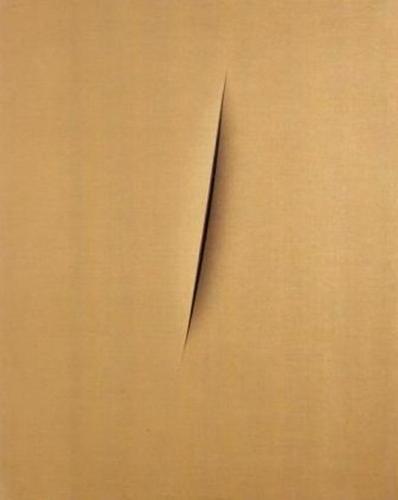 |
| Lucio Fontana, Concetto Spaziale, Attesa, 1960 |
I had heard not very good things about the
Lucio Fontana exhibition at the Musée d’Art Moderne de la Ville de Paris. At
dinner last week, a friend looked appalled as she announced that over half the
exhibition is taken up with ceramics and sculpture. It’s true: it took Fontana
a long time to find his unique contribution to the history of art. In fact, it
wasn’t until the 1950s, that is, halfway through the exhibition, that he starts
putting holes in his canvases, and slicing them open. Up until this point his
work is derivative and not very interesting. Even the early cut works are not
so exciting, appearing as little more than thinly painted canvases with holes
in them. It’s not until the 1960s, when he does nothing but cut and making
holes in the canvas — the final rooms of
the exhibition — that the works come to be anything more than mediocre works
with theoretical or historical rigour.
 |
| Lucio Fontana, Concetto Spaziale, Attese, 1966 |
One thing that surprised me (once I got to
the final rooms of the exhibition) was that even though I always knew Fontana’s
cuts are the ultimate iconoclastic gesture, I didn’t realize how little they
have to do with painting. At times, the canvas is not even painted, but a piece
of thin, almost transparent fabric covers the canvas and so the canvas is not
even cut. The works are almost all entitled Concetto
spaziale (Spatial Concept) thereby indicating the three-dimensional,
articulation of an object in and as space, rather than as two dimensional
images. And yet, while they are not about painting, the works are about the history
of art. Fontana’s slicing open of the canvas speak a violence, disrespect,
defacement, denigration of all that can be imagined by such a gesture. The act
of cutting the face of the canvas, even when there is nothing on the canvas, is
perhaps the most definitive act of iconoclasm.
 |
| Lucio Fontana, Concetto Spaziale, New York 10, 1962 |
Along with the displacement of the canvas
as image, there is nothing to look at, even though the visual appearance of the
canvas is always different from image to image. Visually, each spatial concept
is like a repetition of those on either side of it. Whether there is one cut or
a series of cuts, it doesn’t seem to make a difference, and we seem to be
looking at a single concept being reiterated over and over again. And then, in the
last few rooms — the 1960s — everything comes together a matter of years before
Fontana dies. In the end, the works are about the sense of touch, they are
erotic, they are gendered, imaginative, and somehow transport us to another
level of experience. The cuts become a moment that we sense, an anterior
moment, because it is as though we are looking at that moment of cutting
itself. We get to feel the curve of the gesture of slitting – it’s incredibly
sensuous. The cuts as the trace of the artist, are sensuous, physical, and they
are no longer revealing violation, but some kind of spiritual belief, a calling.
As Fontana approaches the end of his life, the cut is a creation, not a
violation. But of course, it is still a violation because it slices the canvas
open, however lovingly. And there is no mistaking that these are the gestures
of a powerful male artist, making incisions that remind of female genitalia. Around
the edges of the holes the paint is coagulated, where it has dried up, it is
thick, we want to touch it, it is so tempting it arouses desire.
 |
| Lucio Fontana, Concetto Spaziale, 1962 |
In the final room of paintings, the holes
on the canvas become bigger, they become gorgeous until there are more of the
holes than the canvas. Finally, we realize, Fontana is an artist exploring the void.
What in the early years was about making painting into sculptural, expressing
the materiality of the canvas through its incision, by the late 1960s, Fontana
is building sculptures that are constantly cutting away the material and all
materiality, to find the nothingness. While the museum blurbs kept emphasizing
Fontana’s interest in space and spatial organization, the works also strive
towards its opposite, a non-space, absence.
 |
Lucio Fontana, Concetto Spaziale. la Fine di Dio, 1966
|
It’s a spiritual practice – he’s actually a
kind of romantic artist, not as modern as I have always assumed. At least,
where the work might be modern in its material challenge to the identity and
status of representation, especially painting, the most interesting dimension
is the spiritual. Fontana strives for some kind of transcendence himself and we
get to sense that journey.
Images courtesy Musée d'Art Moderne de la Ville de Paris





No comments:
Post a Comment